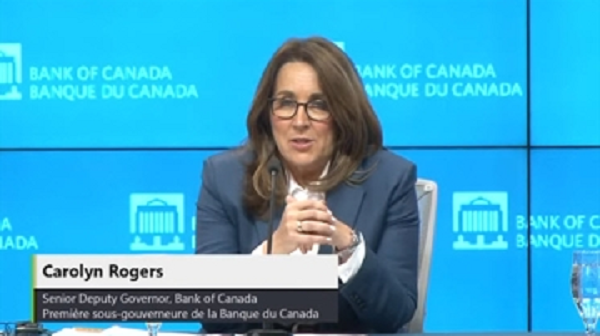Bank of Canada warns of low business investment ‘emergency,’ making it difficult to control inflation
The Bank of Canada is warning that weak productivity and low business investment has become a national “emergency,” making it harder to control inflation and risking the erosion of living standards.
In a speech in Halifax, Senior Deputy Governor Carolyn Rogers said that Canada is slipping further behind the United States and other peer countries when it comes to economic output per worker.
She pointed to weak business investment, meager competition and a failure to properly integrate skilled immigrants into the Canadian workforce.
“I’m saying that it’s an emergency – it’s time to break the glass,” the central bank’s second-in-command told the business audience on Tuesday morning.
Canada has long lagged the United States when it comes to how much the economy produces per hour of work. But the situation has gotten worse over the past decade, especially coming out of the pandemic. Before the final quarter of last year, productivity had declined for six straight quarters.
“Back in 1984, the Canadian economy was producing 88 per cent of the value generated by the US economy per hour,” Ms. Rogers said.
“That’s not great. But by 2022, Canadian productivity had fallen to just 71 per cent of that of the United States. Over this same period of time, Canada also fell behind our G7 peers, with only Italy seeing a larger decline in productivity relative to the United States.”
There are numerous theories about why Canadian productivity is so poor, despite having a well-educated workforce, a strong research culture and access to foreign markets through trade agreements.
Ms. Rogers focused on the lack of business investment in machinery, equipment and intellectual property. Here she pointed to weak competition in Canada and regulatory uncertainty as potential culprits.
“Canada’s economy features many sectors where companies face limited levels of competition, whether from firms in other provinces, foreign rivals or new entrants,” she said. “Of course, every country has certain sectors that it champions, and there can be valid reasons to protect local businesses. However, too much protection can lead to problems.”
She also said the country needs to do a better job integrating new workers into the economy. Boosting productivity entails both giving workers better equipment, and making sure their education and skills match the work they are doing.
“Too often, new Canadians are working in jobs that don’t take advantage of the skills they already possess. And too often these people wind up stuck in low-wage, low-productivity jobs. Doing better at matching jobs and workers is crucial to the future of Canada’s economy,” Ms. Rogers said.
Weak productivity is not only undercutting overall growth, it’s making the central bank’s job of controlling inflation more difficult, she said. If companies are becoming more productive, they can earn higher profits and pay better wages without passing cost increases along to customers. But if productivity lags, rising labour costs tend to show up in higher prices.
“Increasing productivity is a way to protect our economy from future bouts of inflation without having to rely so much on the cure of higher interest rates,” Ms. Rogers said.
The speech mostly avoided talking about near-term monetary policy decisions, although Ms. Rogers noted that inflation remains above the bank’s target and said that “we need to finish the job.”
The bank’s next interest rate decision is on April 10.
This article was first reported by The Globe and Mail















